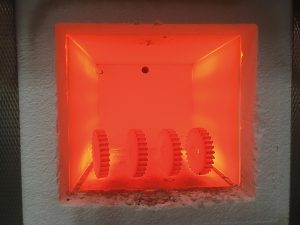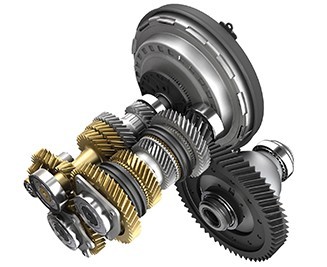Cars, motorcycles, machinery—gears are at the heart of them all. Dr Ing. Ann Zammit writes about challenges in producing and improving gears to make everything safer.

Gears are often considered a symbol of human ingenuity: a product of humankind’s efforts to use physical and mechanical principles to its advantage. In their basic form, they are toothed wheels that mesh together to make things turn, transferring power from one moving gear to another. Many of history’s great minds have dedicated time to these mechanisms. The earliest mention of gears likely came from Aristotle, who observed how ‘rotation is reversed when one gear wheel drives another gear wheel’. Later, in the 15th century, Leonardo da Vinci gave us the Madrid Codices, two manuscripts chock full of inspired designs for gears and gadgets that would revolutionise our thinking.
However, a discovery in 2013 has shown that the original invention of gear mechanisms should be merited to none other than Mother Nature. The Issus bug has evolved curved, cog-like strips of teeth on its hind legs that interlock and rotate like a mechanical gear, enabling the creature to hop from plant to plant. Interestingly, this feature is only present in the young insect, and scientists have speculated that loss of the Issus’ intricate gear system occurs alongside the loss of its self-repair abilities. The baby bug can replace a tooth on the gear, but the adult cannot, so it would be too risky for the adult to rely on the mechanism.
In an attempt to surpass nature, researchers at the Department of Metallurgy and Materials Engineering at the University of Malta (UM) are designing materials that would extend the lifespan of gears and make them more resistant to cracks and general wear. Mechanical gears have so many applications, ranging from the movement of a watch’s hands, to the power transmission systems of industrial machines, so having a combination of desirable properties, both in terms of strength and longevity, would provide massive benefits to industry and society as a whole.
In 2006 Prof. Ing. Maurice Grech and I teamed up to investigate a material called Austempered Ductile Iron (ADI) for use in automotive gears.
Changing material structure for improved toughness

ADI is widely used for vehicle components by companies worldwide: General Motors, BMW, and Renault, to name a few. The material itself is a type of cast iron that has an impressive combination of properties, including high strength, high toughness, and a great damping capacity that can reduce vibrations in the moving parts. A heat treatment process called ‘austempering’ improves these properties, and a big part of the research is dedicated to optimising this.
As a first step, the base material is heated in an electric box furnace, reaching scorching temperatures between 850°C and 1000°C. The material is then quenched in a bath of liquid salt maintained between 250°C and 450°C. The gears are left there for enough time to transform their underlying crystal structure, before being cooled to room temperature. By applying this thermal cycle to the material and changing its microstructure, its properties can be improved. A key point is to choose the exact temperature; this critical step will greatly affect the final outcome.
Generally speaking, when good wear resistance is desired, low austempering temperatures, somewhere between 230°C and 330°C, are chosen. If the final product needs high toughness and resistance to bending, austempering is carried out at higher temperatures—around 350°C to 400°C.
In an ideal world, we would have a combination of high toughness and good wear resistance, but the perfect mix has proven elusive. A potential solution would be to use a two-step approach, whereby the high toughness required in the core of a gear is achieved by austempering in the higher temperature range of 350°C to 400°C. Subsequently, the material is further processed using surface modification techniques to improve its wear resistance.
 Durability and the surface of gears
Durability and the surface of gears
After optimising the heat treatment to strengthen the core of our gears, further decisions need to be made to achieve the best possible longevity. A common method we are using to improve the surface is called shot peening. Bombarding the surface with round metallic, glass, or ceramic particles under controlled conditions leads to compression of the material, causing it to relieve tensile stresses and harden. Different intensities and shot materials can provide different results, adding to the long list of parameters that need to be considered.
For example, an important finding of the experiments carried out by our group is that repeating the process of peening significantly improved results. A first round of larger shots creates deep hardened layers, and a second round of smaller diameter shots improves the surface finish, removing areas of roughness that are likely to cause problems. Another smooth-finishing process being studied uses a high-power laser beam to harden the surface with minimal distortion. Having all these possible methods to choose from makes testing long and arduous.
Solving a complex puzzle
Finding the optimal combination of parameters to use, both in the heat treatment and surface engineering processes, is a huge challenge. There are so many potential variable combinations that the complex task is akin to solving a Rubik’s cube. A single turn can make the colours line up on one side whilst messing up another side completely, moving us further away from the final solution. Ultimately these engineering choices need to be driven by a lot of testing and data collection, to help make sense of this complex puzzle.
After improving the process on test coupons (small example pieces of the material), the research team is now beginning to test on actual gear systems. Dr Ing. Glenn Cassar has joined the effort and we are also seeking out industrial collaborators. This is an essential step in bringing the manufacturing and mechanical insights gained over the previous years onto the road as part of the gear systems of cars. Our ultimate goal is to perfect the systems that are already taken for granted, and improve lives, one gear at a time.





Comments are closed for this article!